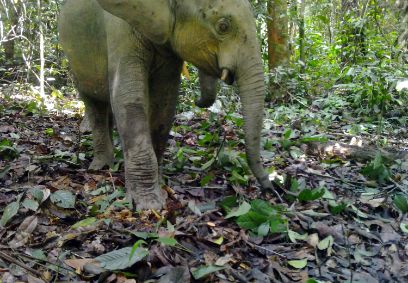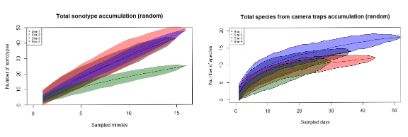- News
Rainforest data pool
02.07.2021 BFH-HAFL graduate Isaac Youb cares deeply about the forest and its inhabitants. In his master's thesis, the Gabonese researched the efficiency of special technologies that can help protect species.

Worldwide, around 1 million species are threatened with extinction. The Global Report of the UN World Biodiversity Council (IPBES) sums it up thus: ‘Transformative change is necessary to reverse the immense loss of biodiversity in nature.’ To effect this change, animals and their habitats need to be monitored. But this is not easy. ‘It is not only access to remote areas which makes this difficult but also the sheer diversity of species and their living habits,’ says BFH-HAFL graduate Isaac Youb (see box). ‘Monitoring devices help enormously here.’ For his master's thesis, Youb compared the efficiency of bioacoustic recorders and camera traps in the rainforest of Gabon in Africa. ‘You need hands-on research to find out whether these devices work reliably in a particular environment.’
In the following interview, Youb reveals how his research in the field went and what he learned from it.
Mr Youb, how did your interest in wildlife monitoring come about?
Before my master's degree, I worked for the timber management company Precious Woods. Monitoring projects were part of my daily work. I assessed whether the condition of permanent monitoring plots met the criteria of sustainable forest management. For my master's thesis, I wanted to focus more on forest conservation. My supervisor, Jürgen Blaser, who works closely with Precious Woods, put me in touch with Zuzana Burivalova, a professor at the University of Wisconsin in the USA. She is a widely known expert in wildlife monitoring.
What was the aim of your research and how did you go about it?
We wanted to find out whether camera traps or bioacoustic devices are more efficient for recording biodiversity in a given environment. This is central for a sound basis to the data collected. The data, i.e. which animals live there and how they behave, help us manage the forests. Using these data, we can better plan which forestry work can be carried out, how and when, so as not to endanger the animals. We installed the two devices in four different types of forest in the Precious Woods concessions in Gabon. This allowed us to build up an extensive database of sounds and images. We compared which device was faster, which detected more animals in the four different taxonomic groups birds, insects, amphibians and mammals and whether the environment had an influence on the data collected.
Isaac Youb
Before studying at BFH-HAFL, Isaac Youb worked at Precious Woods. He obtained his master's degree in January 2021. He now wants to apply the knowledge he has acquired in an international company or NGO. He very much enjoyed his time in Switzerland: ‘I love rösti, chocolate, fondue and cordon bleu,’ Youb says with a wink. ‘I also like the short distance from the school to a big city. The ease with which you can travel from city to city by train in Switzerland is amazing.’
Were there any dangerous situations while working in the rainforest?
Being alone in the tropical forest can be risky because of the many wild animals. That's why I was always with at least one co-worker. Together we carried the ladder which we used to attach the equipment to the trees at a height of 7 metres and removed the vegetation in front of and around the places where we installed the equipment. But working in the forest is the most beautiful thing for me. It is a fantastic experience to observe elephants, lowland gorillas and hippos in the wild and to bathe in the many rivers and streams after a long day's work.
What were your findings? Are camera traps or sound-recording devices better?
Looking at all the data, bioacoustic recorders were found to be more efficient than camera traps, both in terms of the speed of wildlife detection and the number of species recorded in the same period of time. While the camera traps only recorded mammals and a few bird species, the bioacoustic recorders recorded birds, insects, amphibians and mammals. The reason for this is probably the ability of these devices to record sounds from distant animals. If we had only used camera traps, we would have concluded that the species diversity was the same in all four environments. However, the soundscape then showed us that this was not the case. For comprehensive monitoring, I recommend combining both devices.

What are your ideas for the future?
Here in Gabon, there are currently many initiatives using digital devices to conserve biodiversity. My idea is to build a professional network to share existing knowledge in the region. Another idea would be to create a database with the collected and interpreted sounds per study area and thus create an open-source database for exchange between scientists.
(This text first appeared in the BFH-HAFL magazine infoHAFL 01/2021).